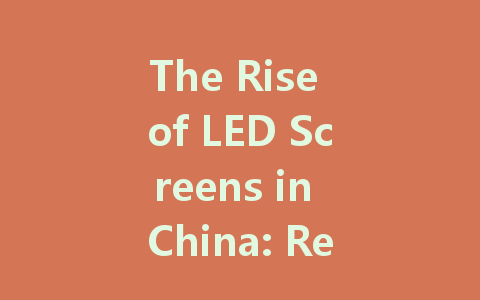
In recent years, China has emerged as a major player in the display technology industry, particularly in the development and production of LED screens. These screens have transformed sectors ranging from advertising to education, offering vibrant visuals and unparalleled versatility. In this article, we will explore the factors contributing to the rise of LED screens in China, their applications, and what the future holds for this technology.
The Growth of the LED Screen Industry
Manufacturing Powerhouse
China’s manufacturing capabilities have played a significant role in the rapid growth of the LED screen industry. With a plethora of factories and skilled labor, the nation has positioned itself as the world’s leading producer of LED display panels. The country is home to numerous companies specializing in various aspects of LED technology, from fabrication to assembly, which contributes to lower production costs and high efficiency.
Innovation and Research
Innovation drives every successful technology, and the LED screen industry is no exception. Chinese companies invest heavily in research and development to push the boundaries of what LED technologies can do. These innovations include higher resolutions, improved energy efficiency, and the introduction of flexible display options. As a result, consumers benefit from more advanced products, enhancing their overall experience.
Diverse Applications of LED Screens
Advertising and Marketing
One of the most visible applications of LED screens is in advertising. Billboards and digital signage dominate urban landscapes, providing businesses with a dynamic platform to showcase their products and services. Cities like Shanghai and Beijing feature large LED displays that attract attention and deliver messages in real time. Advertisers can easily change content, allowing for tailored campaigns based on specific events or audiences.
Entertainment and Events
LED screens have redefined live events, bridging the gap between performers and audiences. Concerts, sports matches, and festivals now utilize large LED displays to enhance the viewing experience, ensuring that fans can see every detail regardless of their location. These screens also allow for immersive experiences, integrating video, lighting, and effects to create a captivating atmosphere.
Education and Training
In educational settings, LED screens have proved to be valuable tools for teaching and engagement. Schools and universities are increasingly adopting LED displays for classrooms and lecture halls, providing a visually appealing way to present information. Interactive features allow educators to engage students more effectively, catering to diverse learning styles and preferences.
The Environmental Impact of LED Technology
Energy Efficiency
One of the most significant advantages of LED screens is their energy efficiency. Compared to traditional display technologies, such as LCD and plasma, LED panels consume considerably less power. This not only results in cost savings for businesses but also aligns with global sustainability goals. As environmental awareness grows, many companies are shifting to LED technology to reduce their carbon footprint and promote eco-friendly practices.
Longevity and Durability
LED screens are known for their long lifespan and durability. With proper maintenance, these displays can last over 50,000 hours, reducing the need for frequent replacements. This durability contributes to lower waste and resource consumption, further benefiting the environment.
Challenges and Future Outlook
Market Competition
Despite its rapid growth, the LED screen industry in China faces fierce competition. Numerous domestic and international players are vying for market share, which can lead to price wars and reduced profit margins. Companies must prioritize innovation and customer service to differentiate themselves in this crowded marketplace.
Regulatory Considerations
As the industry matures, regulatory frameworks are evolving to ensure product quality and safety. Companies must comply with increasingly stringent standards, which may require investments in quality control and certification processes. Embracing these regulations can have long-term benefits, as consumers become more discerning about product quality.
Future Trends
Looking ahead, the LED screen industry is poised for continued growth. Emerging technologies such as OLED (Organic LED) and MicroLED are gaining traction, offering even higher color accuracy, contrast ratios, and flexibility. These advancements will likely drive the development of new applications, from wearable devices to expansive outdoor displays.
Conclusion
The rise of LED screens in China represents a remarkable journey of innovation, efficiency, and transformative applications. As the nation solidifies its status as a global leader in display technology, the impact of these screens will be felt across various sectors, enhancing everyday experiences and promoting sustainable practices. With ongoing advancements on the horizon, the future of LED screens promises to be bright, exciting, and full of possibilities.